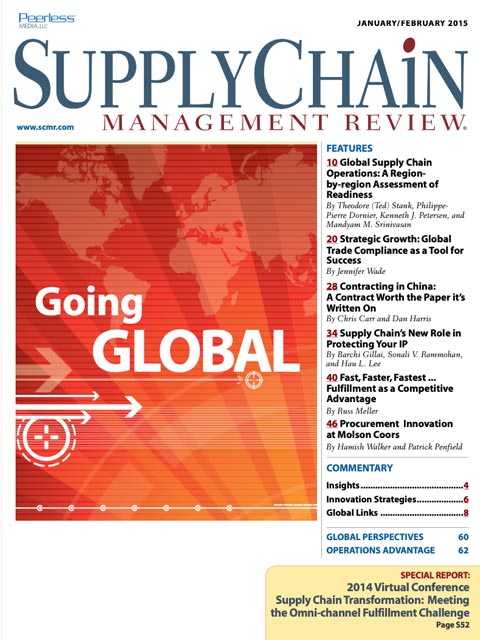Sorry, but your login has failed. Please recheck your login information and resubmit. If your subscription has expired, renew here.
January-February 2015
As long as there have been boats and beasts of burden, intrepid business professionals, governments, and marauders have sought fame, fortune, wealth, and value by going global. Think the Phoenicians, Marco Polo, and the Vikings in days of old. Or in contemporary times, think of China, BRIC, EMEA, and other emerging markets. One could argue that outsourcing to China a few decades ago gave birth to supply chain management as we think of it today. This month we’re including an online bonus column from APQC. While this issue focuses on global management, we didn’t want to miss out on the column. Browse this issue archive.Need Help? Contact customer service 847-559-7581 More options
The bar has been raised. Almost every company is working to reduce the time it takes to get an order to a customer’s home or to its stores. They are following Amazon’s lead in offering next-day, and even same-day delivery. A recent survey showed that 65 percent of buyers want next-day delivery. And another survey showed that 24 percent of online buyers said same-day delivery was important to them. All of this is putting pressure on retailers as well as industrial distributors to rev up their cycle times for fast, faster, and fastest fulfillment times compared to their competitors.
While Amazon is in the news, this is not just an e-commerce arms race. Companies are moving faster to replenish their stores too, in order to keep less inventory at each retail location and cut inventory across the entire network.
 |
This complete article is available to subscribers
only. Click on Log In Now at the top of this article for full access. Or, Start your PLUS+ subscription for instant access. |
It’s not just cycle and fulfillment times that are changing; there has also been a fundamental change in the profile of those orders being fulfilled. E-commerce orders are typically one to two items. Store replenishment order profiles are also getting smaller, and are beginning to resemble e-commerce orders, as stores receive cartons and mixed cartons several times a week rather than pallets and mixed pallets less frequently. One specialty retail client now carries only a single unit of its slowest-moving products on its retail shelves. Yet, thanks to a faster store replenishment model, the retailer has increased its in-stock position from 90 percent to 97 percent while decreasing inventory by 25 percent. As with e-commerce, single item and partial case orders are harder and more expensive to process. Any company in the retail or industrial fulfillment business has to balance the competitive pressures to satisfy its customer expectations while minimizing the costs of extra handling and speedier delivery. We believe the following methodology demonstrates that an investment in faster fulfillment can deliver a competitive advantage for a wide variety of companies.
SC
MR
Sorry, but your login has failed. Please recheck your login information and resubmit. If your subscription has expired, renew here.
January-February 2015
As long as there have been boats and beasts of burden, intrepid business professionals, governments, and marauders have sought fame, fortune, wealth, and value by going global. Think the Phoenicians, Marco Polo, and… Browse this issue archive. Access your online digital edition. Download a PDF file of the January-February 2015 issue.
 |
Download Article PDF |
The bar has been raised. Almost every company is working to reduce the time it takes to get an order to a customer’s home or to its stores.
They are following Amazon’s lead in offering next-day, and even same-day delivery. A recent survey showed that 65 percent of buyers want next-day delivery. And another survey showed that 24 percent of online buyers said same-day delivery was important to them. All of this is putting pressure on retailers as well as industrial distributors to rev up their cycle times for fast, faster, and fastest fulfillment times compared to their competitors.
While Amazon is in the news, this is not just an e-commerce arms race. Companies are moving faster to replenish their stores too, in order to keep less inventory at each retail location and cut inventory across the entire network.
It’s not just cycle and fulfillment times that are changing; there has also been a fundamental change in the profile of those orders being fulfilled. E-commerce orders are typically one to two items. Store replenishment order profiles are also getting smaller, and are beginning to resemble e-commerce orders, as stores receive cartons and mixed cartons several times a week rather than pallets and mixed pallets less frequently. One specialty retail client now carries only a single unit of its slowest-moving products on its retail shelves. Yet, thanks to a faster store replenishment model, the retailer has increased its in-stock position from 90 percent to 97 percent while decreasing inventory by 25 percent. As with e-commerce, single item and partial case orders are harder and more expensive to process. Any company in the retail or industrial fulfillment business has to balance the competitive pressures to satisfy its customer expectations while minimizing the costs of extra handling and speedier delivery. We believe the following methodology demonstrates that an investment in faster fulfillment can deliver a competitive advantage for a wide variety of companies.
 |
SUBSCRIBERS: Click here to download PDF of the full article. |
SC
MR


Latest Supply Chain News
- Technology’s role in mending supply chain fragility after recent disruptions
- Tech investments bring revenue increases, survey finds
- Survey reveals strategies for addressing supply chain, logistics labor shortages
- Israel, Ukraine aid package to increase pressure on aerospace and defense supply chains
- How CPG brands can deliver on supplier diversity promises
- More News
Latest Podcast

 Explore
Explore
Latest Supply Chain News
- Technology’s role in mending supply chain fragility after recent disruptions
- Tech investments bring revenue increases, survey finds
- Survey reveals strategies for addressing supply chain, logistics labor shortages
- Israel, Ukraine aid package to increase pressure on aerospace and defense supply chains
- How CPG brands can deliver on supplier diversity promises
- How S&OP provides the answer to in-demand products
- More latest news
Latest Resources

Subscribe

Supply Chain Management Review delivers the best industry content.

Editors’ Picks





